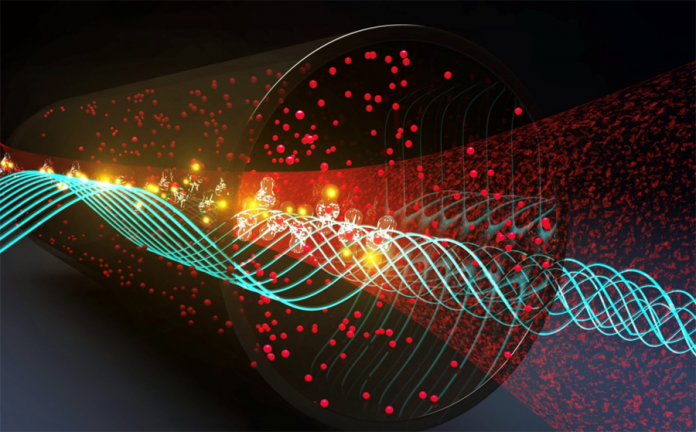
Professor Barry Dunning discusses new research in quantum electric field sensors using Rydberg atoms of a higher sensitivity
Electromagnetic (EM) radiation is critically important to the functioning of modern technological society in areas such as telecommunications, radar, and GPS navigation. Whereas EM waves are now typically detected using antennae and electronic receivers, recent work using atoms in highly-excited states, termed Rydberg atoms, has demonstrated that, following in the footsteps of quantum sensors of time (atomic clocks) and magnetic fields (magnetometers), controllable quantum systems can also provide a powerful electric field sensor (electrometer) that has the potential to reach unprecedented levels of sensitivity and selectivity. Quantum-based atomic sensors have the advantage over more traditional technologies in that all atoms of a given species possess identical characteristics which allows for repeatable, high precision measurements that can be directly related to known absolute standards.
As highlighted in a recent e-book,† atoms in which one electron is excited to a Rydberg state possess many novel characteristics. In particular, as their level of excitation increases they become very large and can approach the size of a grain of sand. The excited electron orbits so far from the nucleus and remaining electrons that the electric field it experiences from them is very weak. In consequence, its motion can be strongly perturbed by even very small external electric fields and it is this sensitivity that forms the basis for the use of Rydberg atoms in electrometry. Indeed, at room temperature even a perfect vacuum represents a hostile environment for a Rydberg atom due to its interactions with background thermal blackbody radiation emitted by the walls of its enclosure.
Rydberg-based EM field detection exploits a phenomenon termed electromagnetically-induced transparency (EIT). A typical experimental arrangement comprises a small glass gas cell filled with an atomic vapor through which is directed two counter-propagating laser beams. The “probe” laser is tuned to excite atoms in the cell to a low-lying excited state, the “control” laser is tuned to excite the atoms from this low-lying state to a selected Rydberg state. In the absence of the control beam the probe laser beam is strongly absorbed due to excitation of atoms in the cell. The addition of the control beam leads to creation of a quantum “dark” state that involves a superposition of the ground and excited states that opens a narrow window in the transmission of the probe beam. The introduction of an additional external EM field leads to so-called Autler-Townes splitting and AC Stark shifts that perturb the dark state and lead to changes in the transmission window. These changes are sensitive to the strength and frequency of the field and can be observed through measurement of the probe beam transmission. Techniques commonly used in radio receivers, such as the use of a local oscillator in a heterodyne configuration, can further enhance sensitivity

Rydberg atom sensors have been demonstrated that can detect EM radiation over a broad spectral range spanning kilohertz to terahertz frequencies which extend from the AM and FM radio bands to Bluetooth and WiFi signals and beyond. Furthermore, the use of small vapor cells allows spatially-localized observations of electric field strengths such as, for example, at points within a microwave wave guide without perturbing the local field as would introduction of an antenna. Rydberg atom measurements can also be directly related to known physical constants and can therefore provide accurate absolute electric field values that can be used to calibrate more conventional antenna-receiver combinations. While current experiments have already demonstrated the remarkable sensitivity of Rydberg electrometers, the creation of even more sensitive sensors appears feasible whose performance is ultimately limited by quantum noise itself and the extent to which this is true is an active area of research.
Since the response of Rydberg sensors to EM radiation can be highly frequency specific, they promise higher transmission capacities in congested electromagnetic environments, especially when high bandwidth is not required, such as, for example, for transmitting speech. This capability also enables accurate measurement of the Doppler shifts that result from the reflection of EM waves from a moving target allowing measurement of velocities from a few micrometers to a few kilometers per second, a range that covers cell migration to hyper-velocity projectiles. Furthermore, laboratory-based studies have demonstrated that Rydberg atom sensors can be used to determine the direction of incoming radiation, and hence the location of its source.
While use of Rydberg atoms as quantum electric field sensors is still in its infancy, they have demonstrated that they can provide superior performance over current technology as regards sensitivity, resistance to interference, broad tunability, accuracy, and small physical size. These capabilities speak to future applications not only in defense and communications, but also in more specialized fields such as radio-astronomy and Doppler velocimetry.
F.B. Dunning
Sam and Helen Worden Professor of Physics
Rice University, Houston, TX 77005
† Giants on the atomic landscape, Open Access Government Research and Development on-line e-book, February 2022, available from openaccessgovernment.org.









